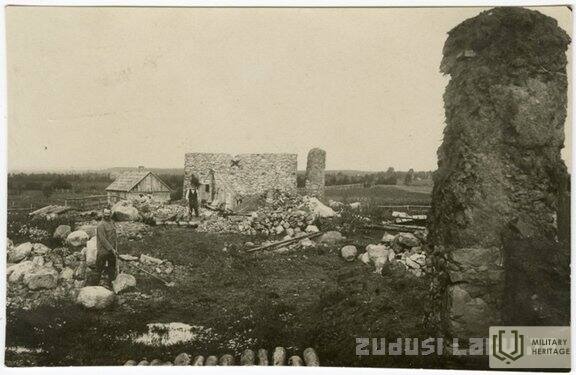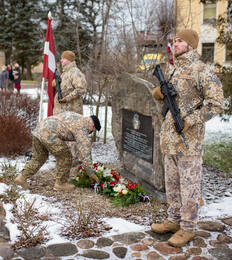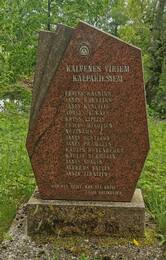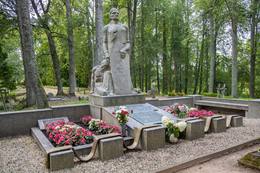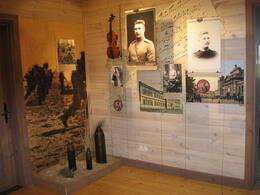Skrunda lahing
I Maailmasõda, I Maailmasõda ja iseseisvumine
Läti Rahvuskaart alustas 29. jaanuaril 1919. aastal pealetungi, mille eesmärk oli Skrunda linna vallutamine.
Lahingus osalesid lisaks Vene kompaniile ja Saksa jalaväepataljoni ühele kompaniile ka Läti iseseisva pataljoni instruktorkompanii ja Cēsise kompanii. Rünnakule aitas kaasa pool Saksa suurtükiväepatareist.
Skrunda mõisa läheduses oli 2. Nõukogude Läti Laskurirügemendi 1. pataljon. Rünnak algas kell 4.00 ja kell 11.00 hakkas vaenlane Skrunda kirikust ja Skrunda mõisast taganema.
Skrunda lahing oli esimene edukas rünnak Ajutise Valitsuse relvajõudude poolt Vabadussõjas.
Rohkem teabeallikaid
Kaotatud Läti – Läti vabadusvõitluste lahinguväli Skrunda mõisas (zudusilatvija.lv)
Seotud ajajoon
Seotud objektid
Skrunda lahingu mälestus- ja lipupäev
Skrunda lahingumälestusmärk asub Skrunda kesklinnas, Oskaras Kalpaka pargis Skrunda kultuurimaja lähedal, Kuldīgase ja Liepājase tänava ristmikul. 2005. aastal püstitati mälestusmärgile kivi, mis meenutab 29. jaanuari 1919. aasta lahingut, mil Oskars Kalpaka juhitud pataljon koos Landeswehri saksa ja vene üksustega vabastas Skrunda enamlaste käest. Alates 2004. aastast on säilinud lipupäeva traditsioon, millega mälestatakse esimest enamlastest vabastatud linna ja selle vabastajaid, kes heiskasid 29. jaanuaril 1919 Skrunda kiriku juures Läti lipu.
Vabadussõja esimestel kuudel kaotas Läti Ajutine Valitsus bolševike surve all kiiresti territooriumi. 22. jaanuaril 1919 vallutasid enamlased Skrunda. Nädal hiljem, 29. jaanuari varahommikul, algas pealetung Skrunda tagasi vallutamiseks. Läti eraldi pataljon kolonelleitnant Oskars Kalpaksi juhtimisel pidi ründama piki Rudbāržu-Skrunda maanteed ja ajama bolševikud Skrundast välja. Sellele pidi järgnema Saksa üksuste külgrünnak, mille ülesandeks oleks hävitada edasitungiv vaenlane, samal ajal kui Vene kompanii ründaks Läti ja Saksa üksuste vahel, kasutades Skrunda kirikut maamärgina. Rünnakut toetas ka Saksa suurtükipatarei. Rünnaku päeval oli 15 kraadi külma, päike paistis eredalt, Kalpakkidel tuli läbida puhas väli ja enamlased varjusid mõisa kivihoonetes. Kui ründajaahel oli umbes 300 meetri kaugusel, avasid enamlased tule, puhkes kahepoolne tulekahju ja Oskars Kalpaksi juhitud sõdurid tungisid kiirelt edasi, sundides vaenlast tule lõpetama ja taganema üle Venta. Pärast umbes 3 tundi kestnud võitlust vallutati Skrunda umbes kell 9 hommikul, kusjuures Läti eripataljonil oli ainult 2 haavatut.
Skrunda lahing oli Läti Ajutise Valitsuse relvastatud Spek-sõdurite moraalile väga tähtis, sest see oli tegelikult esimene märkimisväärne võit lahingutes enamlaste vastu. Pealegi näitas ülem ise, Oskars Kalpaks, selles lahingus erilist julgust, julgustades oma eeskujuga sõdureid mitte kartma.
Monument ja mälestusmärgid O. Kalpaka pataljoni sõduritele Aizpore kalmistul
Umbes poolel teel Rudbārži ja Kalvė vahel, A9 maanteega paralleelselt kulgeva vana tee ääres, asub Aizpore kalmistu.
Seal on monument ja 12 mälestusmärki Oskars Kalpaka pataljoni vabatahtlikele sõduritele, kes elasid ümbritsevates majades.
Kalvene valla Aizpore poolmõis oli kõige kaugem koht, kuhu Läti Erakondlik (Kalpaka) pataljon 22. jaanuaril 1919. aastal taganes. Siin sai pataljon Liepājast oma esimese tugevduse - 35 meest - ja alustas vastupealetungi, jõudes 24. jaanuaril Rudbārži.
Mälestusmärgi püstitamise idee tekkis 1920. aastatel, kui 1. Läti Separatiivpataljoni ehk Kalpaka pataljoni endised sõdurid püstitasid ajutise mälestustahvli - tammeploki koos mälestustahvliga. Toona sündis mõte luua suurem mälestusmärkide ansambel, kuid see sai teoks alles 15. mail 1993, kui avati mälestusmärk - Valguskiir -, mis on hallist graniidist obelisk.
2,3 m kõrgune mälestusmärk on valmistatud skulptorite Harijs SPRINCIS ja Imants LUKAŽIS (1930 - 2007, maetud Aizpuri kalmistule) poolt, kelle isa oli samuti O. Kalpaka pataljoni sõdur. Mälestustahvlile on graveeritud luuletaja E.VIRZA nimed:
KALPAKAM
AND HIS
SÕDURITELE
1919
25. JAANUARI HOMMIKUL
SIIT PÄEVASTI
KA ALATES
TULI
ÜLE LATVIA
Samal ajal tähistati kalmistule maetud 12 Kalpaku hauad tammepuust mälestustahvlitega, mis 2019. aastal asendati graniidist mälestustahvlitega.
1990. aastate alguses püstitati kalmistule kahe meetri kõrgune mälestusmärk, mille kõrval kasvab tamm, mille istutas 1990. aastate keskel legendaarne näitleja Ēvalds Valters.
Kolonel Oskars Kalpaksi viimane puhkepaik
Asub Visagala kalmistul, Madona linnaosas
10. juulil 1927 avati Oskars Kalpaksile Kārlis Zāle ja Arnolds Dzirkaļsi valmistatud monument - kolmest figuurist koosnev kompositsioon, mille keskmes on muistne läti sõdalane kilbi ja mõõgaga käes, kuid mõlemal. sides on vehklev sõdur. Skulptuurigrupi jalamile on graniitalusele asetatud pronkstahvel, millele on graveeritud tekst, millel on ka Kalpakile pühendatud Edward Virza luuletus.
Oskars Kalpaks langes 1919. aastal. 6. märtsil "Airīte" lähedal, Skrunda - Saldus maantee poolsel küljel, 18. septembril viidi tema säilmed Liepāja põhjakalmistult üle Visagala perekonnakalmistule.
Monumendi avas kolonel O. Kalpaksi monumendikomisjoni esimees kindral J. Balodis, osalesid tollane president G. Zemgale, peaminister M. Skujenieks, Riigikogu esimees P. Kalniņš, sõjaminister R. Bangerskim ja K. Ulmanis. Monumendi aluskivi pandi 19. juunil 1925. aastal. Monumendi kivi on võetud polkovniku kodumajast Siena rabast, sellel kivil armastas O. Kalpaks lapsena viiulit mängida.
Oskars Kalpaksi muuseum ja mälestuspaik "Airītes"
Oskars Kalpaksi muuseum ja mälestuspaik Airītes asub Salduse ja Skrunda vahel, A9 maantee lähedal. Näitus sisaldab ulatuslikku teavet kolonel Oskars Kalpaksi ja tema pataljoni kohta ning tutvustab Läti Rahvusarmee ajalugu ja mälestuspaika Airītes. Näitus näitab kolonel Oskars Kalpaksit kui isiksust, sõdurit ja Läti iseseisvuse eest võitlejat. Ekspositsiooni osana on saadaval ka läti, inglise ja saksa keeles heliprotokollid. Need rõhutavad 1918/1919. aasta ajalooliste sündmuste tähtsust Läti riikluse kaitsmisel. Muuseumihoone on restaureeritud.
Sissepääs on tasuta; giidiga ekskursioon - tasuline. Kompleksis on puhkeala, park, takistusrada, on võimalik võtta mitmesuguseid kursusi, samuti on olemas seminarisaal kuni 30 inimesele.
Seotud lood
Aizporu poolmõis Vabadussõjas
Aizporu poolsaar, Aizpute rajoon, Kalvene vald, on läänepoolseim koht Lätis, kuhu kolonel Oskars Kalpaksi eraldi pataljon taganes.
Rudbārži ja Kalvenė poolsaarel on Aizpore kalmistu. Seal on mälestusmärk ja 12 mälestusmärki Oskars Kalpaka pataljoni vabatahtlikele sõduritele.




